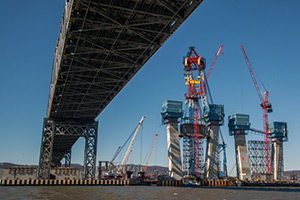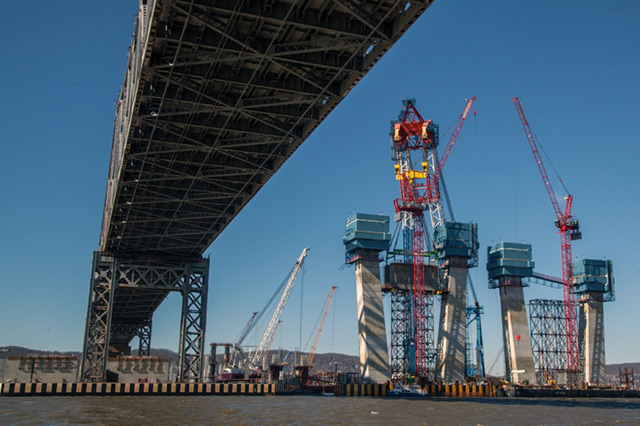New N.Y. Bridge Paid for by Wall Street Crime

 New York State Thruway Authority
New York State Thruway AuthorityThe replacement for the Tappan Zee Bridge, which is rising out of the waters of the Hudson River, is called “The New NY Bridge” by Gov, Andrew Cuomo.
A better name might be the BNP Paribas Bridge or the Global Banking Malefactors Bridge, said E.J. McMahon, president of the Empire Center for Public Policy, a research group that advocates for less government spending.
In the past two state budgets, Cuomo and the Legislature have allocated $2 billion in bank settlement money to the New York State Thruway Authority to pay for a new $4 billion span and to freeze tolls on the Thruway’s 570-mile system through 2020.
The windfall is limiting the authority’s need to borrow for the 3.1-mile bridge, which is expected to be completed in 2018. At the same time, it’s allowing the Thruway to put off toll increases to back that project and billions of dollars in other borrowing needed for roads and bridges, raising risks for bondholders, according to Moody’s Investor Service.
“This uncertain and delayed timeframe for toll adjustments raises risks to bondholders that toll rates may not be adjusted in time and sufficiently to meet required operational and debt obligations,” Moody’s said in an April 18 report. “The longer the delay in rate increases, the higher the likelihood of rate shock” leading to lower traffic volume."
On April 4, investors will get a chance to put a price on that risk when the Thruway issues $850 million of bonds, its first-ever subordinate lien long-term debt, to help fund the eight-lane bridge connecting Rockland and Westchester counties about 27 miles north of New York City.
The junior debt is rated A3 by Moody’s, its seventh-highest investment grade, one level lower than the rating on the authority’s $3.2 billion of senior bonds. A majority of the securities being offered April 4 mature in 40 years.
Some of the most actively traded Thruway bonds, which come due in 2032, sold for a yield of 2.54% on April 3, about 1 percentage point more than top-rated debt. That gap, a measure of the risk perceived by investors, has changed little since the securities were issued in late 2014.
David Ambler, a credit analyst at AllianceBernstein Holding in New York, said uncertainty about Thruway tolls wasn’t “a big negative.”
“Absent those toll increases, they’ve articulated a game plan,” Ambler said. “It’s obviously difficult to raise the tolls, there’s no doubt about it. They’ve come up with a methodology to get breathing room.”
The Thruway has been the biggest recipient of $8.3 billion of settlement funds New York has collected from 15 banks and insurance companies for offenses, including transactions on behalf of countries such as Iran and Sudan that are subject to U.S. embargoes. The biggest chunk, $3.6 billion, has come from BNP Paribas, France’s largest bank, which in 2014 agreed to plead guilty for violating sanctions.
In addition to settlement funds and its own bond sales, the Thruway also is using a $1.6 billion federal loan to finance the new bridge.
The bank settlement cash has enabled the authority, which oversees one of the longest U.S. toll roads, to subsidize drivers’ fees that already are low compared with its peers, according to Moody’s.
The Tappan Zee Bridge’s current $5 passenger-car tolls are a third less than the $15 it costs to cross the George Washington Bridge or take the Holland and Lincoln tunnels from New Jersey to New York. On the Thruway itself, passenger cars pay 5 cents per mile. That compares with 13 cents for cars on the Pennsylvania Turnpike.
Cuomo “has basically established toll suppression on the Thruway as a priority,” McMahon said. “I don’t know why, because it’s not a subject of dinner table conversation.”
The governor’s office sees it differently. “E.J. must not be eating dinner with anyone who commutes on the Thruway,” said Morris Peters, a spokesman for Cuomo’s budget division. “The Thruway is a vital artery for commerce and transportation, and that’s why the governor has frozen tolls until at least 2020 and established a task force to look closely at the issue before increased tolls impact anyone’s cost of living.”
The task force set up in November has yet to meet.
The Tappan Zee opened in 1955 and was built to last 50 years. It carries 138,000 vehicles a day, 40% more than its original design intended, clogging traffic, according to the Thruway.

